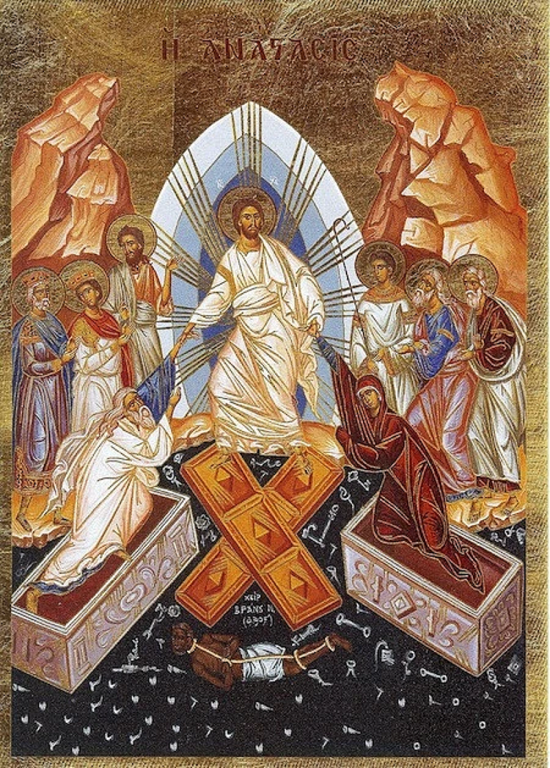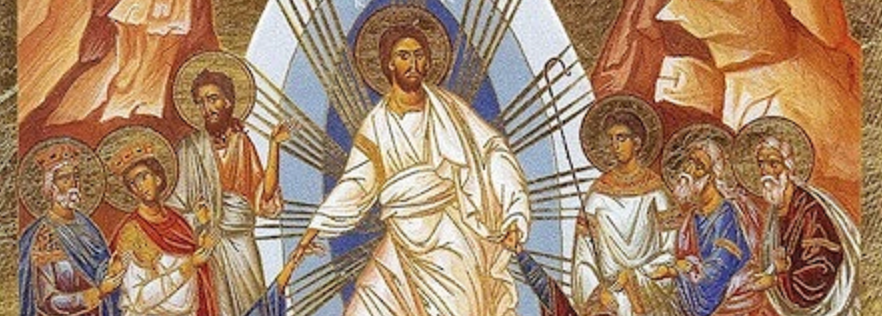Who Is Risen?
Easter Vigil Scripture Readings

The gospels present a description of the Resurrection that is anything but clear. Because there are four different stories told from the perspective of the four different gospel writers, it’s not possible to come up with anything like an historically accurate narrative, or even to surmise which of the descriptions comes closest to describing the actual events. We’re quite certain that something amazing happened, and there are certain facts that were reported in common that we can grab hold of as we struggle to make sense of it.
The chronology is certain: Jesus was arrested on a Thursday evening. He was tried, convicted, sentenced, and executed the following day, on Friday. His body was taken down from the cross and given a hurried burial in a nearby tomb before sunset that day because the Sabbath began at sundown and nothing more could be done. Some women came to the tomb at daybreak on Sunday—the day after the Sabbath. They came to mourn, which was an obligation for friends and relatives of the deceased (especially women at that time), and several gospel writers report that they brought spices…perhaps to finish the incomplete burial preparations.
All the gospel writers agree that the women found the tomb empty when they arrived. They were confused, distraught, and fearful. Some reported that they saw visions of a man dressed in gleaming white robes who told them to return to Galilee, where they’d see Jesus. In addition, there were various reports of sightings of Jesus himself—sometimes by the women, sometimes by the disciples. Matthew is the only one to report that the woman actually saw the stone being rolled away and the guards being struck unconscious. Even taken together, we still can’t get anything close to a clear understanding of what they experienced.
So, you see, we can’t say much about the Resurrection based on the gospel narratives themselves. What we do know is that, after that experience, everything changed for the disciples. The lifeless body of the crucified Jesus, so familiar and recognizable until then, was gone now, replaced by a resurrected body no longer constrained by the laws of physics. The experience of the Resurrection was, for the disciples, an experience of transcendence, wholly outside the realm of earthly human experience. No wonder they had such a difficult time describing what happened. How does one go about describing an indescribable experience?
The one fact that all the witnesses and gospel writers could agree on was that Jesus of Nazareth died, and then was no longer dead but the essence of who Jesus was still lived. They continued to have a relationship with him, and he with them. They also understood that what they experienced in the Resurrection of Jesus was a reality that they, too, would share. They knew that Jesus had broken through the barrier that death had set up to life and, if they but followed him, that barrier would become a mere illusion for them as well. The risen Jesus was not the illusion, it was death itself that had been shown to be unreal.
After realizing that Jesus had opened a way through death to life for them, they came to another, equally profound realization: that is, that they didn’t have to wait for their mortal bodies to lie in death to live the life of the Resurrection. It was happening to them now. And, as a sign of their passage through death, leaving selfish self-interest, fear, and resentment behind, they provided us with Baptism as our way of experiencing and participating in the Resurrection. The Resurrection is not for Jesus alone, otherwise, he’d still be walking around here giving interviews. The Resurrection is equally as much for us. It’s happening. We’re part of it, and nothing can take that life away from us—not even death.
Surely, we celebrate that Christ, once raised from the dead can never die again. But the real celebration this Easter is our commemoration of the Resurrected life that is ours today, and that we share with all who have put to death selfish self-interest. It’s so easy to forget that we’re alive and where that life that can never be taken away comes from. That’s what Easter is really about. That’s our “Alleluia!”
Get articles from H. Les Brown delivered to your email inbox.
